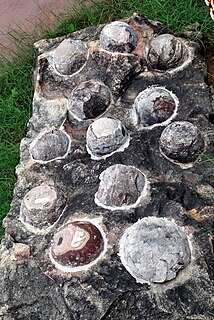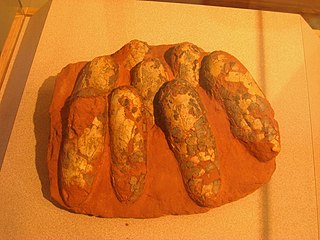Kenneth Carpenter is a paleontologist. He is the former director of the USU Eastern Prehistoric Museum and author or co-author of books on dinosaurs and Mesozoic life. His main research interests are armored dinosaurs, as well as the Early Cretaceous dinosaurs from the Cedar Mountain Formation in eastern Utah.

The Barun Goyot Formation is a geological formation dating to the Late Cretaceous Period. It is located within and is widely represented in the Gobi Desert Basin, in the Ömnögovi Province of Mongolia.
The Sigou Formation is a Late Cretaceous geologic formation in China. Fossil dinosaur eggs have been reported from the formation, including Dictyoolithus.

The Gaogou Formation is a Late Cretaceous (Cenomanian-Turonian) geologic formation in China. Fossil dinosaur eggs, the caenagnathid Beibeilong, and the titanosaur Baotianmansaurus have been reported from the formation.

Dendroolithus is an oogenus of Dendroolithid dinosaur egg found in the late Cenomanian Chichengshan Formation, in the Gong-An-Zhai and Santonian Majiacun Formations of China and the Maastrichtian Nemegt and Campanian Barun Goyot Formation of Mongolia. They can be up to 162 mm long and 130 mm wide. These eggs may have been laid by a Therizinosaur, Sauropod, or Ornithopod. The oospecies "D." shangtangensis was originally classified as Dendroolithus, however, it has since been moved to its own distinct oogenus, Similifaveoloolithus. This oogenus is related with embryos of the theropod Torvosaurus
Dictyoolithus is an oogenus of dinosaur egg from the Cretaceous of China. It is notable for having over five superimposed layers of eggshell units. Possibly, it was laid by megalosauroid dinosaurs.
Stromatoolithus is an oogenus of dinosaur egg. The oogenus contains one oospecies, S. pinglingensis.
Sphaerovum is an oogenus of dinosaur egg that has only been discovered in South America.
Ovaloolithus is an oogenus of dinosaur egg. Eggs of the genus have been found in China, Mongolia and Utah.
Shixingoolithus is an oogenus of dinosaur egg from the Cretaceous of Nanxiong, China.

Spheroolithus is an oogenus of dinosaur egg.

Macroelongatoolithus is an oogenus of large, fossil theropod eggs. They are known from Asia and from North America.

Macroolithus is an oogenus of dinosaur egg belonging to the oofamily Elongatoolithidae. The type oospecies, M. rugustus, was originally described under the now-defunct oogenus name Oolithes. Three other oospecies are known: M. yaotunensis, M. mutabilis, and M. lashuyuanensis. They are relatively large, elongated eggs with a two-layered eggshell. Their nests consist of large, concentric rings of paired eggs. There is evidence of blue-green pigmentation in its shell, which may have helped camouflage the nests.

Egg fossils are the fossilized remains of eggs laid by ancient animals. As evidence of the physiological processes of an animal, egg fossils are considered a type of trace fossil. Under rare circumstances a fossil egg may preserve the remains of the once-developing embryo inside, in which case it also contains body fossils. A wide variety of different animal groups laid eggs that are now preserved in the fossil record beginning in the Paleozoic. Examples include invertebrates like ammonoids as well as vertebrates like fishes, possible amphibians, and reptiles. The latter group includes the many dinosaur eggs that have been recovered from Mesozoic strata. Since the organism responsible for laying any given egg fossil is frequently unknown, scientists classify eggs using a parallel system of taxonomy separate from but modeled after the Linnaean system. This "parataxonomy" is called veterovata.

This timeline of egg fossils research is a chronologically ordered list of important discoveries, controversies of interpretation, taxonomic revisions, and cultural portrayals of egg fossils. Humans have encountered egg fossils for thousands of years. In Stone Age Mongolia, local peoples fashioned fossil dinosaur eggshell into jewelry. In the Americas, fossil eggs may have inspired Navajo creation myths about the human theft of a primordial water monster's egg. Nevertheless, the scientific study of fossil eggs began much later. As reptiles, dinosaurs were presumed to have laid eggs from the 1820s on, when their first scientifically documented remains were being described in England. In 1859, the first scientifically documented dinosaur egg fossils were discovered in southern France by a Catholic priest and amateur naturalist named Father Jean-Jacques Poech, however he thought they were laid by giant birds.
Hemifaveoloolithus is an oogenus of fossil dinosaur egg from the Tiantai basin in Zhejiang Province, China. It is a faveoloolithid, having spherical eggs roughly 13 cm in diameter. The shell is distinctive for being composed of four or five superimposed layers of shell units, and the honeycomb-like arrangement of pore canals.

Elongatoolithidae is an oofamily of fossil eggs, representing the eggs of oviraptorosaurs. They are known for their highly elongated shape. Elongatoolithids have been found in Europe, Asia, and both North and South America.
Dictyoolithidae is an oofamily of dinosaur eggs which have a distinctive reticulate organization of their eggshell units. They are so far known only from Cretaceous formations in China.

Gobioolithus is an oogenus of fossil bird egg native to Mongolia. They are small, smooth-shelled, and elongated eggs that were first discovered in the 1960s and early 70s during a series of fossil-hunting expeditions in the Gobi desert. Two oospecies have been described: Gobioolithus minor and G. major. The eggs were probably laid in colonial nesting sites on the banks of rivers and lakes.

The Dushihin Formation is an Early Cretaceous (Aptian) geologic formation in the Övörkhangai Province of Mongolia. The formation preserves fossils of Psittacosaurus mongoliensis and fossil eggs described as Trachoolithus faticanus.










